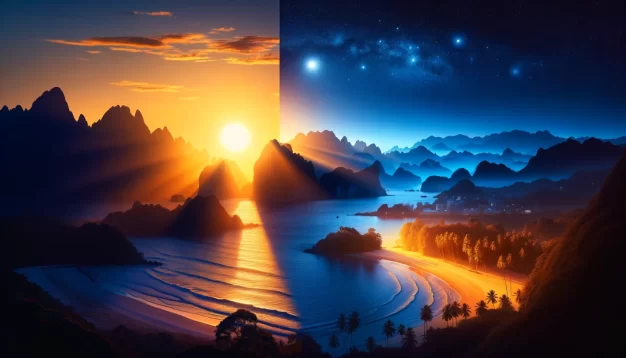
Introduction to Golden and Blue Hours
The Magic of Light in Photography
Light dictates the mood of a photograph. The subtleties of dawn and dusk offer a palette of colors and tones that can transform the ordinary into the extraordinary.
Understanding Golden and Blue Hours
Golden and Blue Hours are pivotal for photographers, providing natural lighting that can elevate images from mundane to magnificent. These periods occur just after sunrise and just before sunset (Golden Hour), and during the twilight phase (Blue Hour).
Golden Hour Explained
Characteristics of Golden Hour Light
During Golden Hour, the sun is low in the sky, producing a warm, diffused light. Shadows are softer, and highlights are less likely to be overexposed. This light flatters landscapes, portraits, and cityscapes.
Best Practices for Golden Hour Photography
To exploit Golden Hour, plan ahead. The light changes rapidly, so timing is crucial. Experiment with silhouettes, long shadows, and backlit subjects. Focus on capturing the soft textures and warm tones.
Blue Hour Unveiled
Defining Blue Hour’s Unique Ambiance
Blue Hour is the twilight period when the sun is below the horizon, imbuing the sky with a blue hue. This serene light bridges day and night, offering a cool, ethereal quality to photos.
Tips for Capturing Blue Hour Scenes
Stability is key. Use a tripod to prevent camera shake during long exposures. Embrace the blue tones and contrast them with artificial lights, such as street lamps or building windows.
Planning for the Perfect Shot
Apps and Tools to Predict Golden and Blue Hours
Utilize apps like PhotoPills or The Photographer’s Ephemeris to calculate precise times for Golden and Blue Hours. These tools can be indispensable for meticulous planning.
Scouting Locations for Optimal Results
Scout locations in advance. Look for spots where the interplay of natural and artificial light can create compelling compositions during these elusive hours.
Camera Settings and Techniques
Adjusting Exposure for Golden and Blue Hours
In manual mode, start with a low ISO to minimize noise. Adjust aperture according to the depth of field required, and fine-tune shutter speed to capture the desired motion or stillness.
Composition Tips for Dynamic Images
Rule of Thirds can be cliché; dare to break it for dynamic effect. Play with leading lines and foreground interest to add depth. Remember, rules are guidelines, not handcuffs.
Post-Processing Golden and Blue Hour Photos
Enhancing Colors and Contrast
In post-processing, balance the warm and cool tones to reflect the scene accurately. Boosting contrast can add drama, but avoid overdoing it—subtlety is sophistication.
Dealing with Low Light Challenges in Editing
Use noise reduction judiciously; it’s a tool, not a magic wand. Recover details in shadows and highlights, but respect the natural dynamics of the scene.
Conclusion
Recap and Encouragement to Experiment
Golden and Blue Hours present mesmerizing opportunities for photography. Mastering their nuances demands patience and practice. Embrace these moments, experiment boldly, and your portfolio will thank you for it. Remember, the best photograph is the one that reflects your unique vision—technical perfection is secondary to the story you weave with light.